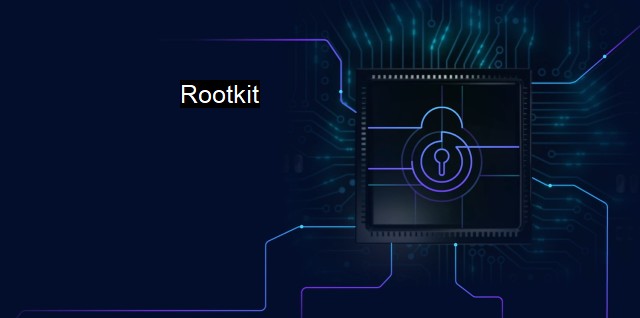What is Rootkit?
Understanding Rootkit Malware: A Stealth Threat to Cybersecurity and Personal Data Security
A rootkit is a collection of software tools that grant an unauthorized user privileged access to a computer or network environment. They are often used by hackers who wish to breach a computer's security defenses without being detected. The term "rootkit" is derived from two words: "root," which refers to the superuser or administrator within the UNIX and Linux operating systems, and "kit," which stands for a collection of software utilities.Rootkits are categorized as one of the most stealthy and destructive tools. Once installed, a rootkit can provide the perpetrator with administrative-level access, allowing them to fully control the affected system or network. They alter the system’s functionality without the user's consent or even awareness.
A rootkit functions by embedding itself deep into a computer's system, including the operating system, to evade detection from standard antivirus software. They accomplish this by intercepting and manipulating operating system calls that are responsible for numerous system operations. Rootkits can even abolish processes and files, intrude on data, and continuously watch a system’s activities without detection.
One of the numerous persuasive aspects of rootkits is their capability to remain latent. Typical virus or malware could bear signatures or patterns that antivirus software can recognize and eradicate immediately. rootkits, due to their deep integration with the system, leave hardly any suspicious traces, proving them immensely elusive.
Rootkit installation can be successful by taking advantage of a system's vulnerabilities or through the execution of deceptively harmless applications loaded by social-engineering maneuvers or malicious email attachments. The administrator rights gained by rootkits enhances their destructiveness, granting them manipulation of system files and frameworks, altering system configuration, creating backdoors for future attacks, or establishing botnets for distributed denial-of-service attacks (DDoS).
Several types of rootkins exist with varying capabilities and concealment levels. There are Kernel rootkits, the most potent type; it directly manipulates kernel commands to achieve ultimate control over the system. Bootkits, infects the Master Boot Record, firmware, or the BIOS system, thereby gaining control when the system is booted. User-mode or application rootkits, alter or substitute standard operating system functions with malicious counterparts.
With their highly invasive and malicious nature, rootkits are an eminent threat to cybersecurity. The best safeguard against them is to pressure prevention rather than remediation. Given rootkits’ crafty bypassing capability to go undetected, once they infiltrate a system, their removal can be a daunting task. Often recovering from a rootkit infection means wiping the system entirely and reinstalling the operating system.
Basic safety measures like frequently updating your system software, being cautious of unfamiliar emails or phishing links, and employing dependable antivirus software can help guard against potential rootkit intrusion. More advanced methods include the usage of a trustworthy inbound and outbound firewall and enabling User Account Control (UAC) in the Windows OS suite.
For detecting and removing installed rootkits, specialized software rootkit detectors, sometimes built as an advanced feature in certain standard antivirus software, can come in handy. They use distinctive strategies, such as signature-based detection, behavioral-based detection, and integrity checking, to hunt for any alteration in the operating system.
Developing proactive defense strategies is crucial in the fight against rootkits. Given the stealthiness and damaging potential of rootkits, there needs to be a constant evolution of security measures and tactics. Emphasizing cybersecurity education will also be instrumental in equipping individuals with the knowledge to stay one step ahead of possible threats posed by rootkits. Remember knowledge is undoubtedly power.

Rootkit FAQs
What is a rootkit in cybersecurity?
In cybersecurity, a rootkit is a type of malicious software that allows hackers to gain administrative access to a computer or network by hiding its presence and activity from antivirus and other security measures.How do rootkits work?
Rootkits work by modifying a computer's operating system or firmware, allowing hackers to gain complete control over the system and its processes. They can hide their presence and activity by intercepting system calls, modifying system files, and using other stealth techniques.What are the dangers of rootkits?
Rootkits can be used to steal sensitive information, monitor user activity, install malware, and control the compromised system remotely. Since they can evade detection by antivirus and other security measures, they can persist on a system for long periods and cause extensive damage.How can I protect my computer from rootkits?
To protect your computer from rootkits, you should maintain up-to-date antivirus and anti-malware software, keep your operating system and other software updated, use a firewall, and be cautious when opening email attachments or downloading software from untrusted sources.Related Topics
Malware detection Cybersecurity threats Antivirus software Firewall protection Zero-day exploits
| | A | | | B | | | C | | | D | | | E | | | F | | | G | | | H | | | I | | | J | | | K | | | L | | | M | |
| | N | | | O | | | P | | | Q | | | R | | | S | | | T | | | U | | | V | | | W | | | X | | | Y | | | Z | |
| | 1 | | | 2 | | | 3 | | | 4 | | | 7 | | | 8 | | |||||||